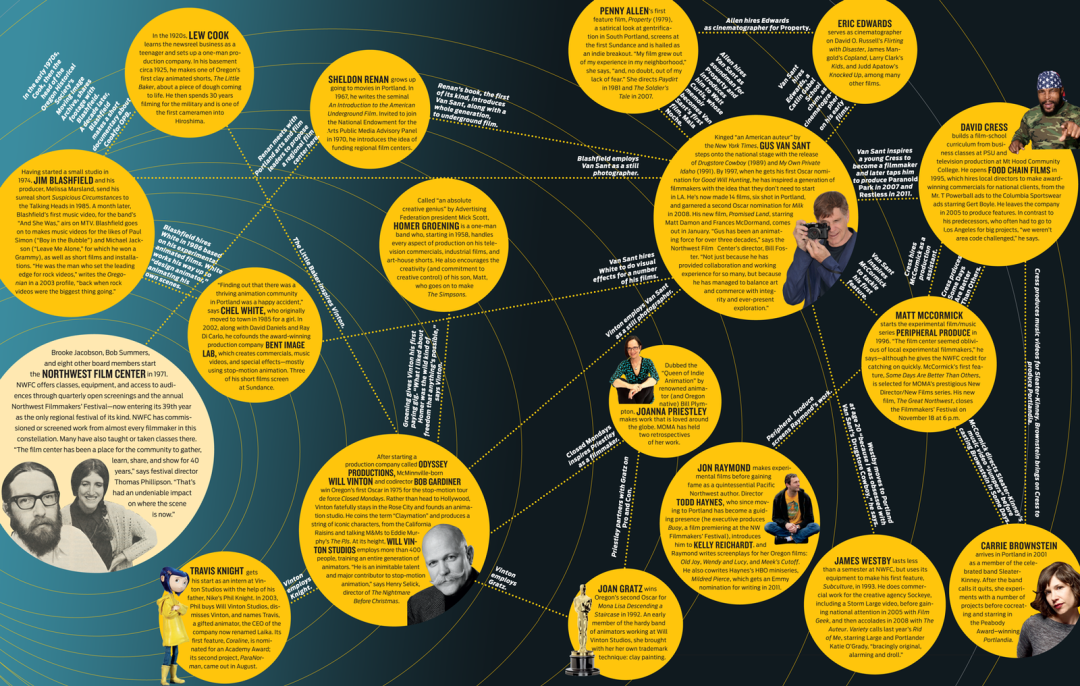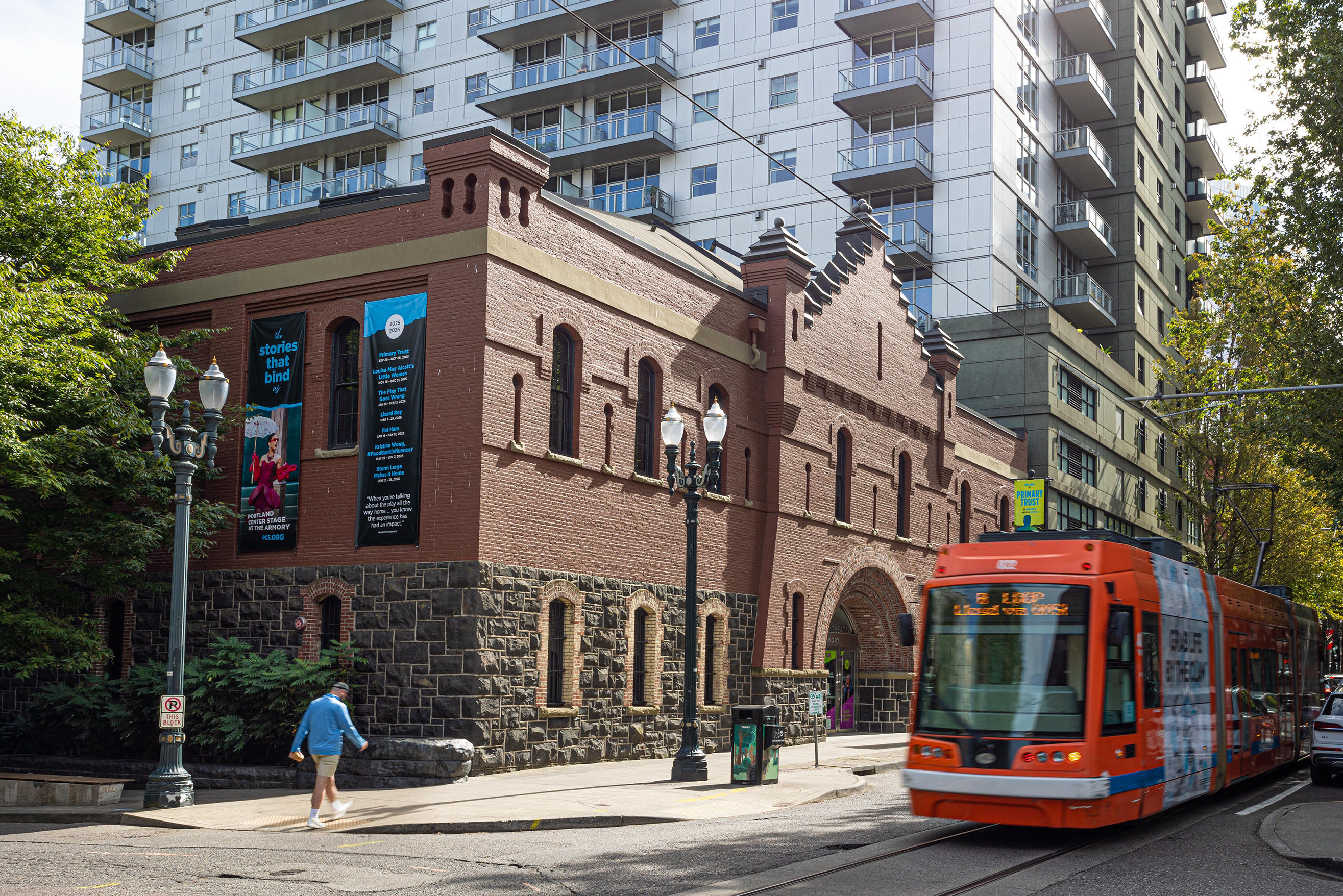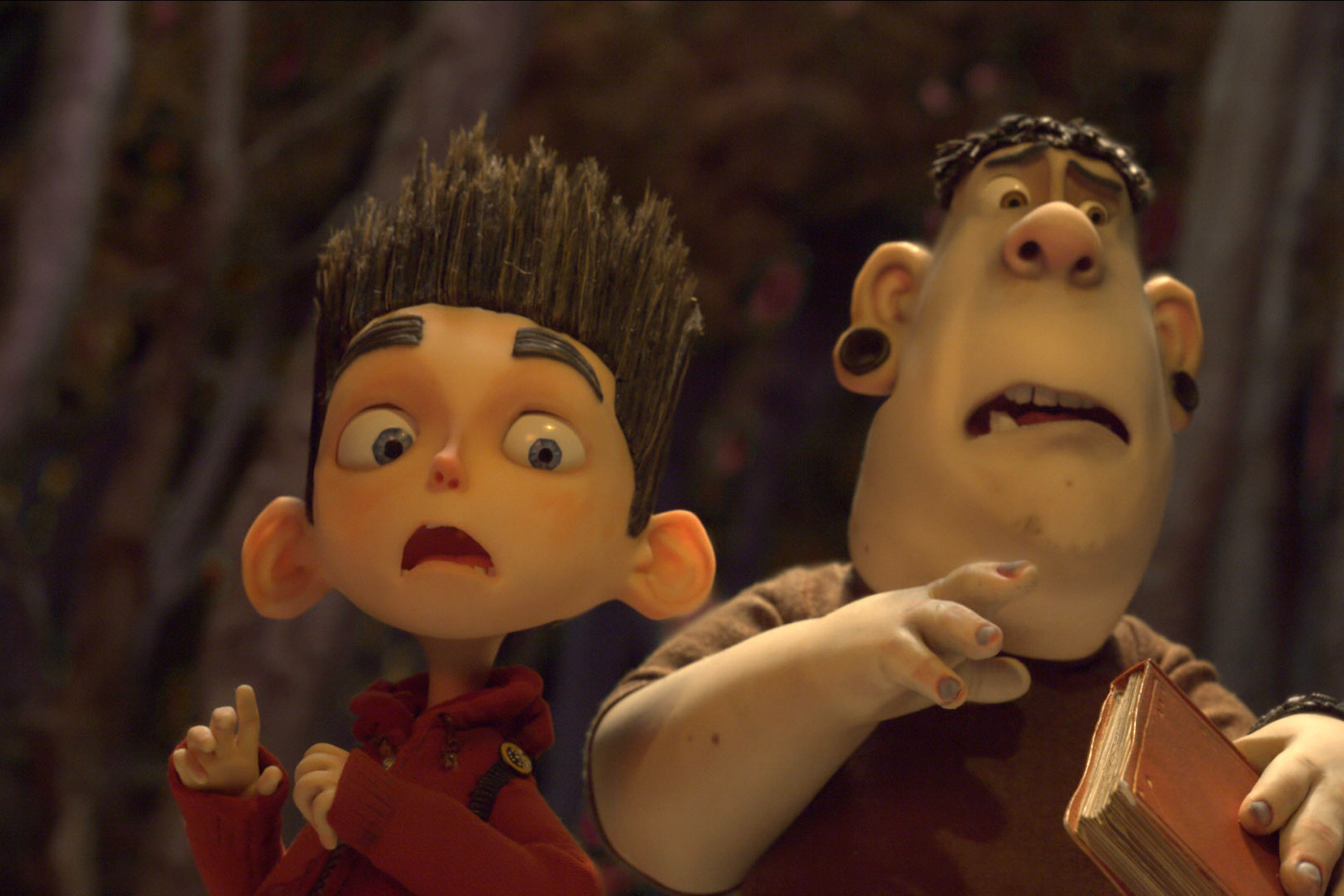NW Filmmakers' Fest Preview and Master Chart

Hey film geeks and neophytes alike, time to brace yourself. That harbinger of local celluloid, the Northwest Filmmakers’ Festival, kicks off nine days of theatrical gluttony this Friday with an opening night of short films and a party, closing out the Northwest Film Center's 40th anniversary season. In honor of the milestone, of the fact that the fest is the only regional fest of its kind, and of the incredibly rich filmmaking community that’s putting Portland on screens across the country (hello, Grimm; hello, Restless), we mapped out the constellation of some of the city’s most influential filmmakers in our November issue. Check it out here.
Drawing from over 400 entries, the Filmmakers’ Fest curated some 28 different screenings spanning the entire spectrum of film: narrative, doc, experimental, animated, shorts. The only constant: filmmakers have to be working in the region. With such a celluloid buffet to choose from, we turned to the fest’s director, Thomas Phillipson, to talk about what’s different this year, what makes Portland’s film scene special, and what films are not to be missed.
Culturephile: Let’s start out with the Fest. Tell us a little about the judge and the lineup this year.
Thomas Phillipson: Just as we do every year, we look for a judge that has a sort of crazy collection of abilities—one who will be respected by the filmmakers and who has a good grasp of what makes an animated film worthy of selection as well as a narrative, documentary, and experimental work. Maureen Selwood is an independent filmmaker specializing in experimental animation who teaches at the prestigious film program at CalArts. She really has all the attributes we could ever hope for.
The lineup is particularly strong this year, and I say that giddily, knowing that nobody watches all these films more times than I do. I’ve seen all of the over 400 entries and have already viewed most of the selected films more than a couple times. I’ll be at all the screenings and will choose about ten shorts for our “Best of the 39th Northwest Filmmakers’ Festival Tour” and will accompany them to venues throughout the Northwest in the year to come. If it weren’t a good lineup, I’d go nuts.
Over 400 films? I’m guessing that it’s a crazy eclectic selection of work. Are there themes running through the films that people should watch for?
If you can find a theme that encompasses this year’s selections, I’ll give you a free pass to the Festival. Aside from all of them being compelling for one reason or another and all of them being made by residents of Northwest North America, the variety is astounding. We are one of the only regional film festivals in the world, so I think people expect a lot of films about lumberjacks and salmon, but honestly, after over a decade of running this Festival, the only common ingredient of all the films selected is sincerity. There is truly something for every palate here—issue-oriented documentaries, laugh-out-loud comedies, mind-altering experimental and state-of-the-art animation. I would tell audiences to just check out the synopses, trust your gut, and try something new too.
Unfair question: if someone can only catch four films, which would you recommend?
I hate to cheat, but I’d select shorts programs—which are really a bunch of films, but in the amount of time you can watch a feature-length masterpiece, we’ll show you ten or so gems that are literally all over the map and will truly give you the most concentrated report on the state of the art of filmmaking in the Northwest that you can find anywhere. We have three shorts programs this year, so there you have three programs not to miss.
I would have to know you better to make my fourth recommendation. If I thought you could handle a feature length experimental animated film, I’d tell you to go see The Colors That Combine To Make White Are Important [Saturday, Nov. 10 at 4:30 pm]. If you were my dad, I’d tell you to go see The Crimes of the d’Autremont Brothers [Tuesday at 7 pm]—it’s about a train robbery in 1923 outside of Ashland, Oregon. If you were an architecture nut (like I am), I’d tell you not to miss Coast Modern [Sunday, Nov. 18 at 4:30 pm], which is a gorgeous tour of stunning West Coast mid-century modern homes with interviews with some formidable architects. But just so I don’t come off as a wuss for dodging your question, I’ll tell you my favorite film of the Festival—one I would recommend to anyone. It’s Matt McCormick’s The Great Northwest [Sunday, Nov. 18 at 6 pm]. It’s experimental in the sense that there is almost no dialogue, but it’s beautifully shot, powerful, funny, elegiac, nostalgic and smart and has many subtle moments of joy, which is really my favorite attribute of a film.
We just ran a feature mapping out the family tree of Portland’s rich indie film landscape. As the director of the NWFF, what’s your assessment of the current shape of film in Portland?
The chart is an eye-opening rendering of the interconnectedness, the fellowship, and the ardently incestuous energy of the creative communities of Portland. These days I’m seeing more and more filmmakers who actually aspire to some sort of mainstream success and are finding it. Short subject filmmakers making their first features and filmmakers finding creative commercial work is not new in Portland, but I’m feeling a recent wave of that sort of thing. The Film Center has always been here to put cameras in the hands of the people and to help them find their voice through filmmaking. It’s very gratifying to see such a lush landscape in Portland, and it definitely motivates us to keep planting seeds and hauling water.
Looking back over the last 40 years, how do you think we ended up with such a verdant film stomping ground?
It might be so verdant today because there hasn’t been a lot of stomping. I might over-generalize a bit, but filmmakers here have traditionally not been caught up in the traps of mainstream movie making with its crippling expectations. They are not intimidated by the medium. They know that film can be just another form of self-expression, like writing a poem or painting a picture or starting your own garage band. Also the community is supportive—we have more art film theaters in Portland than many much larger cities, and we have creative companies like Wieden+Kennedy and LAIKA that give filmmakers a place to enter the commercial world and make a nice living.
What role has the NWFC played in that?
By making filmmaking accessible to everyone, the Film Center has filled an important function in the community. In the ‘90s, with my farm-fresh film degree from the U of O, I came back to Portland, full of rapturous cinema theory, and took a class at the Northwest Film Center to actually learn how to load a 16mm camera. Our School of Film’s hands-on approach to teaching coupled with access to equipment and support all along the film production process has everything to do with why, waiting in a coffee line a few years back, I overheard a man say, “You can’t swing a dead cat around here without hitting a filmmaker.”
The Film Center was founded at an opportune moment (the NEA was looking to fund media arts organizations) by a coterie of filmmakers who wanted to keep making films, to have a place to show them, and a place to pool resources. It naturally became a hub. The School of Film became a place to share knowledge—our faculty is made up of working filmmakers. The NW Fest was one of the first endeavors of the Film Center—a forum to exalt their finest achievements. The rest of the exhibition program fills Portland’s need to see inspiring international work of all genres. I would give tremendous credit to the filmmakers who conjured up the Film Center and to Bill Foster, the Director for most of our forty years, for keeping it alive and vital.
Finally, I couldn’t help but notice that you’ve moved from last year's marketing campaign with photos of cute babies and the tagline "Let the Baby Judging Begin" to this year's glossy bleeding hearts. They’re beautiful, but also macabre and risky. Where did the idea come from?
It’s tough to compete with the riskiness of our filmmakers, but we try. Yes, our marketing campaign last year was about judging babies—like a particularly snide critic might judge a film. Our creative agency pitched the idea with the rhetorical question, “is there anything more wrong?” This year, it’s the filmmaker’s bloody heart on stage. Both these concepts came from Mike Houston and Austin Hilde, a couple of guys we’ve followed through two agencies (Leopold Ketel and Mutt Inc.) who have gone rogue this year and are doing the brilliant work freelance.
When I first started working with them years ago, I explained that the chief distinguishing feature of the NW Fest is that it is FOR the filmmakers and that the marketing needed to reflect our clear understanding, empathy, and celebration of them. The guys proposed we change the name from the Film & Video Festival to the Filmmakers’ Festival. That was immediately appealing to me since the spotlight has always been on the maker. We are one of the few festivals that does not charge the filmmakers an entry fee. We created a free Un-conference during the fest for the filmmakers to come together and share ideas, best practices, and inspiration. We offer the filmmakers Production Service Awards for their next projects and parties with all the free beer they can responsibly consume. We keep looking for ways to help them thrive.
For a schedule of films and ticket information, visit the NW Film Center website. You can also watch trailers for the films discussed in this interview and many others here.
(CLICK TO ENLARGE OUR FILM FAMILY TREE AND SCROLL DOWN FOR A SLIDESHOW OF LOCAL FILMMAKERS AND THEIR WORK)






